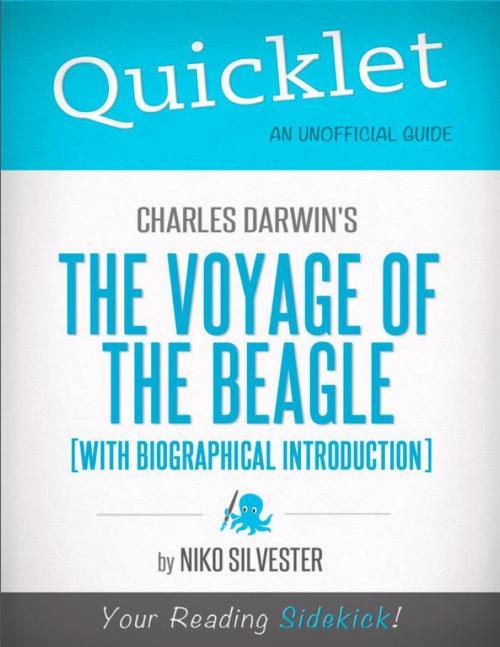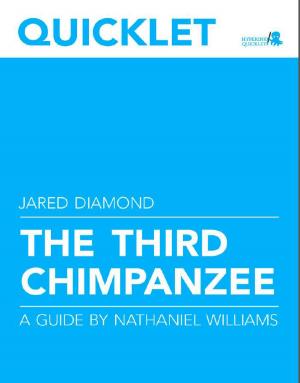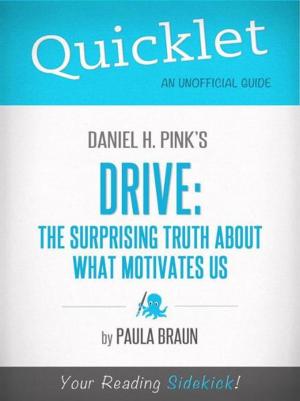Quicklet on Charles Darwin's The Voyage of the Beagle (CliffNotes-like Book Summary)
Nonfiction, Reference & Language, Study Aids, Book Notes, Art & Architecture, General Art| Author: | Nicole Silvester | ISBN: | 9781614641223 |
| Publisher: | Hyperink | Publication: | February 29, 2012 |
| Imprint: | Hyperink | Language: | English |
| Author: | Nicole Silvester |
| ISBN: | 9781614641223 |
| Publisher: | Hyperink |
| Publication: | February 29, 2012 |
| Imprint: | Hyperink |
| Language: | English |
ABOUT THE BOOK
“On the 2nd of October we made the shores of England; and at Falmouth I left the Beagle, having lived on board the good little vessel nearly five years.”
Charles Robert Darwin, the man who brought the world the theory of evolution by natural selection, was born on the 12th of February, 1809, in Shrewsbury, Shropshire, England. From an early age, he showed interest in the study of nature. In 1825, when he was sixteen, Darwin spent a summer as an apprentice to his father, a doctor, and then in the fall of that year he attended medical school at the University of Edinburgh.
Darwin was an indifferent student, finding his lectures dull, and he was distressed by surgery, which was required learning for a doctor. So instead of studying, he turned to other pursuits. He learned taxidermy from John Edmonstone, a former slave who had accompanied an expedition to the South American rainforest; he joined the Plinian Society, a student natural history group; and he assisted Robert Edmond Grant with a study of marine invertebrates, during which time he made and presented at least one discovery of his own.
Due to the neglect of his medical studies, Darwin’s father decided to send him instead to Christ’s College, Cambridge to get a degree as part of the process of becoming an Anglican parson. Darwin continued to neglect his studies, but his newly-found passion for entomology led to some discoveries of new species. Despite being a less-than-stellar student, Darwin graduated in 1831.
MEET THE AUTHOR
Nicole has been writing since she could make letters with a pencil, and has been making a living at it for more than ten years. She has gone back to school too many times, studying archaeology, folklore, writing and visual art. She reads too many books, plays too many video games, and watches too much anime.
EXCERPT FROM THE BOOK
During the years 1831 to 1836, Charles Darwin sailed on the HMS Beagle, on its second hydrographic survey voyage. He kept a diary and detailed scientific notes, and when the expedition returned to England, Darwin began to edit his notes for publication at the request of Robert Fitz Roy, captain of the Beagle. The resulting book, also known as Darwin's Journal of Researches, was first published in 1838 and 1839 as book three of a four-volume publication covering all aspects of both the first and second Beagle voyages. Darwin’s portion covered geology, anthropology and natural history.
Darwin’s family had initially encouraged him to publish his journal separately from Fitz Roy’s account of the voyage, but because it was to be a separate volume in the series, Darwin allowed it to be printed alongside Fitz Roy’s work. However, Darwin’s volume of The Voyages of the Adventure and Beagle was so popular that he did eventually publish the work on its own in 1845, with some revisions. Most notably, he added more references to his developing theory of natural selection. It was reprinted several times, often with slightly different titles, and with minor revisions...
Buy a copy to keep reading!
ABOUT THE BOOK
“On the 2nd of October we made the shores of England; and at Falmouth I left the Beagle, having lived on board the good little vessel nearly five years.”
Charles Robert Darwin, the man who brought the world the theory of evolution by natural selection, was born on the 12th of February, 1809, in Shrewsbury, Shropshire, England. From an early age, he showed interest in the study of nature. In 1825, when he was sixteen, Darwin spent a summer as an apprentice to his father, a doctor, and then in the fall of that year he attended medical school at the University of Edinburgh.
Darwin was an indifferent student, finding his lectures dull, and he was distressed by surgery, which was required learning for a doctor. So instead of studying, he turned to other pursuits. He learned taxidermy from John Edmonstone, a former slave who had accompanied an expedition to the South American rainforest; he joined the Plinian Society, a student natural history group; and he assisted Robert Edmond Grant with a study of marine invertebrates, during which time he made and presented at least one discovery of his own.
Due to the neglect of his medical studies, Darwin’s father decided to send him instead to Christ’s College, Cambridge to get a degree as part of the process of becoming an Anglican parson. Darwin continued to neglect his studies, but his newly-found passion for entomology led to some discoveries of new species. Despite being a less-than-stellar student, Darwin graduated in 1831.
MEET THE AUTHOR
Nicole has been writing since she could make letters with a pencil, and has been making a living at it for more than ten years. She has gone back to school too many times, studying archaeology, folklore, writing and visual art. She reads too many books, plays too many video games, and watches too much anime.
EXCERPT FROM THE BOOK
During the years 1831 to 1836, Charles Darwin sailed on the HMS Beagle, on its second hydrographic survey voyage. He kept a diary and detailed scientific notes, and when the expedition returned to England, Darwin began to edit his notes for publication at the request of Robert Fitz Roy, captain of the Beagle. The resulting book, also known as Darwin's Journal of Researches, was first published in 1838 and 1839 as book three of a four-volume publication covering all aspects of both the first and second Beagle voyages. Darwin’s portion covered geology, anthropology and natural history.
Darwin’s family had initially encouraged him to publish his journal separately from Fitz Roy’s account of the voyage, but because it was to be a separate volume in the series, Darwin allowed it to be printed alongside Fitz Roy’s work. However, Darwin’s volume of The Voyages of the Adventure and Beagle was so popular that he did eventually publish the work on its own in 1845, with some revisions. Most notably, he added more references to his developing theory of natural selection. It was reprinted several times, often with slightly different titles, and with minor revisions...
Buy a copy to keep reading!















